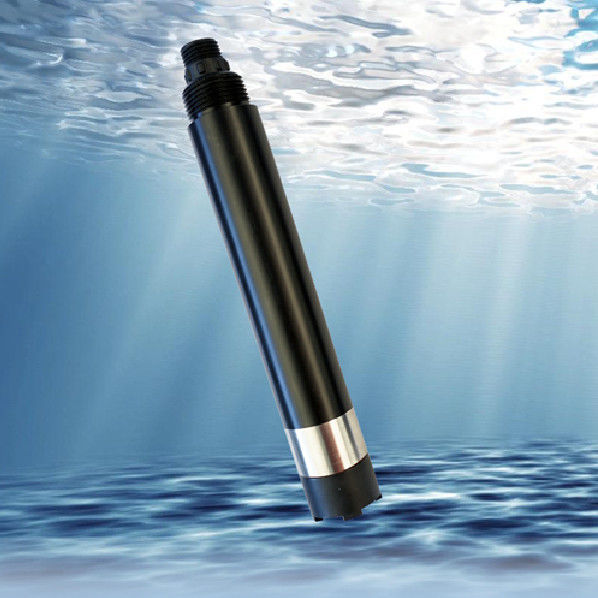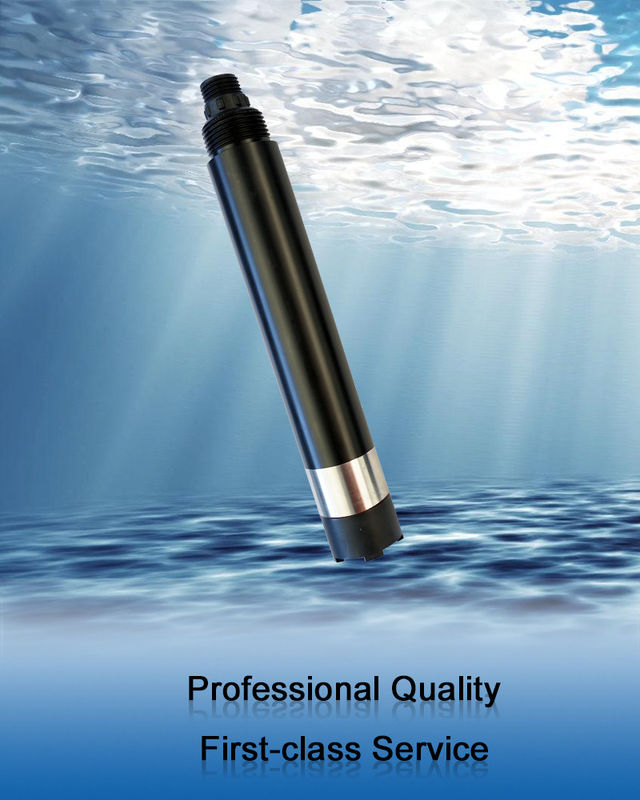KFDO310 integrated on-line fluorescence dissolved oxygen sensor is designed and made based on the quenching principle of excited fluorescence of specific substances in physics. The blue light from the light-emitting diode illuminates the fluorescent material on the inner surface of the fluorescent cap. The fluorescent material on the inner surface is excited and emits red light. By detecting the phase difference between the red light and the blue light, and comparing it with the internal calibration value, the concentration of oxygen molecule can be calculated, and the final value can be output by temperature automatic compensation.
No electrolytes, no polarization
No need to consume oxygen, not affected by the flow rate
Built-in temperature sensor, automatic temperature compensation
Free from chemicals like sulfides
Small drift, fast response, more accurate measurement
Maintenance-free, long service life, lower use cost
Fluorescent caps are easy to replace
RS-485 interface, Modbus-RTU protocol
| Model number |
KFDO310 |
| Measuring principle |
fluorescence |
| Range |
0ー20 mg/L (0ー200% saturation, 25 °C) |
| Resolution |
0.01 mg/l, 0.1 °C |
| Precision |
± 2% f.s. , ± 0.5 °C |
| Temperature compensation |
Automatic temperature compensation (PT1000) |
| Output mode |
RS-485 bus, Modbus-RTU protocol |
| Working conditions |
0ー45 °C, < 0.2 mpa |
| Storage temperature |
- 5 ~ 65 °C |
| Installation mode |
Immersion mounting |
| Cable length |
5 meters, other length can be customized |
| Power consumption |
< 0.05 W |
| Power supply |
12 ~ 24 VDC ± 10% |
| Protection level |
IP68 |
| Calibration |
Two-point calibration |
| Fluorescent cap life |
Guaranteed Use for one year (under normal use) |
| Material for sensor housing |
Pom and 316L stainless steel |


The temperature sensing part should be immersed below the liquid surface to avoid collision with the film head surface. The head part of the membrane should be free from sediment.
Typical Dissolved Oxygen Levels

Dissolved oxygen concentrations can fluctuate daily and seasonally.
Dissolved oxygen concentrations are constantly affected by diffusion and aeration, photosynthesis, respiration, and decomposition. While water equilibrates toward 100% air saturation, dissolved oxygen levels will also fluctuate with temperature, salinity, and pressure changes ³. As such, dissolved oxygen levels can range from less than 1 mg/L to more than 20 mg/L depending on how all these factors interact. In freshwater systems such as lakes, rivers and streams, dissolved oxygen concentrations will vary by season, location, and water depth.
Freshwater Fluctuations: Example 1
In the Pompton River in New Jersey, mean dissolved oxygen concentrations range from 12-13 mg/L in winter and drop to 6-9 mg/L in the summer. That same river shows daily fluctuations of up to 3 mg/L due to photosynthesis production.

 Dissolved oxygen levels often stratify in the winter and summer, turning over in the spring and fall as lake temperatures align.
Dissolved oxygen levels often stratify in the winter and summer, turning over in the spring and fall as lake temperatures align.
Freshwater Fluctuations: Example 2
Studies at Crooked Lake in Indiana show dissolved oxygen concentrations vary by season and depth from 12 mg/L (surface, winter) to 0 mg/L (32 m depth, late summer), with full lake turnovers in spring and fall equalizing DO levels around 11 mg/L for all depths.


In rivers and streams, dissolved oxygen concentrations are dependent on temperature.
Rivers and streams tend to stay near or slightly above 100% air saturation due to relatively large surface areas, aeration from rapids, and groundwater discharge, which means that their dissolved oxygen concentrations will depend on the water temperature ¹. While groundwater usually has low DO levels, groundwater-fed streams can hold more oxygen due to the influx of colder water and the mixing it causes ¹⁵. Standard Methods for the Examination of Water and Wastewater defines dissolved oxygen in streams as the sum of photosynthetic byproducts, respiration, re-aeration, accrual from groundwater inflow and surface runoff ¹³.
Saltwater holds less oxygen than freshwater, so oceanic DO concentrations tend to be lower than those of freshwater. In the ocean, surface water means annual DO concentrations range from 9 mg/L near the poles down to 4 mg/L near the equator with lower DO levels at further depths. There are lower dissolved oxygen concentrations near the equator because salinity is higher.

 Dissolved oxygen levels at the ocean’s surface: (data: World Ocean Atlas 2009; photo credit: Plumbago;
Dissolved oxygen levels at the ocean’s surface: (data: World Ocean Atlas 2009; photo credit: Plumbago;
Wikipedia Commons)
Some states have Water Quality Standard Acts, requiring minimum concentrations of dissolved oxygen; in Michigan, these minimums are 7 mg/L for cold-water fisheries and 5 mg/L for warm-water fish 17; in Colorado, “Class 1 Cold Water Aquatic Life” needs 6 mg/L, and “Class 1 Warm Water Aquatic Life” requires DO levels of at least 5 mg/L 15. In order to mimic ideal environmental systems, freshwater tanks ideally need around 8 mg/L DO for optimum growth and marine tank requirements range from 6-7 mg/L DO based on the salinity level ¹⁸. In other words, dissolved oxygen should be near 100% air saturation.


Dissolved oxygen concentrations decrease as altitude increases (pressure decreases)
Third, dissolved oxygen will increase as pressure increases ¹. This is true of both atmospheric and hydrostatic pressures. Water at lower altitudes can hold more dissolved oxygen than water at higher altitudes. This relationship also explains the potential for “supersaturation” of waters below the thermocline – at greater hydrostatic pressures, water can hold more dissolved oxygen without it escaping ¹. Gas saturation decreases by 10% per meter increase in depth due to hydrostatic pressure ¹². This means that if the concentration of dissolved oxygen is at 100% air saturation at the surface, it would only be at 70% air saturation three meters below the surface.
In summary, colder, deeper fresh waters have the capability to hold higher concentrations of dissolved oxygen, but due to microbial decomposition, lack of atmospheric contact for diffusion and the absence of photosynthesis, actual DO levels are often far below 100% saturation ¹⁰. Warm, shallow saltwater reaches 100% air saturation at a lower concentration, but can often achieve levels over 100% due to photosynthesis and aeration. Shallow waters also remain closer to 100% saturation due to atmospheric contact and constant diffusion ¹⁰.
If there is a significant occurrence of photosynthesis or a rapid temperature change, the water can achieve DO levels over 100% air saturation. At these levels, the dissolved oxygen will dissipate into the surrounding water and air until it levels out at 100%.

 귀하의 메시지는 20-3,000 자 사이 여야합니다!
귀하의 메시지는 20-3,000 자 사이 여야합니다! 이메일을 확인하십시오!
이메일을 확인하십시오!  귀하의 메시지는 20-3,000 자 사이 여야합니다!
귀하의 메시지는 20-3,000 자 사이 여야합니다! 이메일을 확인하십시오!
이메일을 확인하십시오! 


